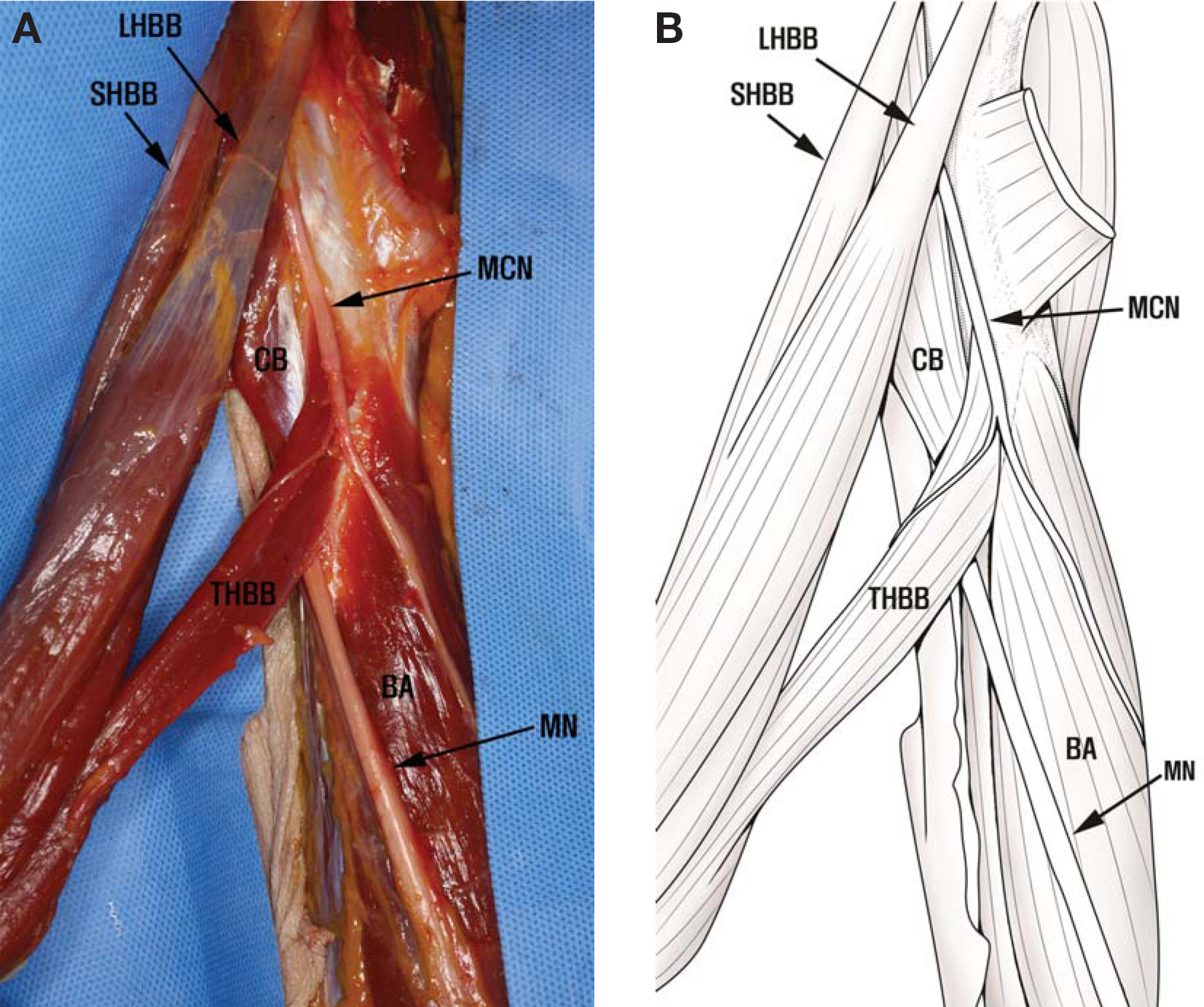Korean J Phys Anthropol.
2013 Sep;26(3):97-100. 10.11637/kjpa.2013.26.3.97.
The Third Head of Biceps Brachii Muscle in Korean: Anatomical Study
- Affiliations
-
- 1Department of Anatomy, College of Medicine, Konyang University of Korea, Korea. leejehun@konyang.ac.kr
- KMID: 1488819
- DOI: http://doi.org/10.11637/kjpa.2013.26.3.97
Abstract
- The goal of this study was to investigate the incidence of third head of biceps brachii (THBB) for understanding unexpected cases in clinical practice. The sample consisted of 214 upper extremities from 107 adult cadavers donated to science (70 males and 37 females; age, 51-87 years). Cases with pathological changes or trauma to the upper limbs were excluded. THBB was found in 14 of the 214 upper extremities. The incidence of variation was approximately 6.5%. THBB was found in 10 male limbs and 4 female limbs, and none of the cases was bilateral. THBB was a flat muscular belly-like structure that originated from the anteromedial surface of the humerus between the insertion of the coracobrachialis and the origin of the brachialis. This finding may be clinically important because the musculocutaneous nerve is subjected to compression by the bulky third head.
Keyword
MeSH Terms
Figure
Reference
-
References
1. Abu-hijleh MF. Three headed biceps brachii muscle associated with duplicated musculocutaneous nerve. Clin Anat. 2005; 18:376–9.2. Ashwini SJ, Shashikala RL. Case report: Third head of bicep s brachii muscle a case study. Biomed Res. 2011; 22:387–9.3. Asvat R, Candler P, Sarmiento EE. High incidence of the third head of biceps brachii in South African populations. J Anat. 1993; 182:101–4.4. Bergman RA, Thompson SA, Afifi AK. Catalogue of human variation. Urban and Schwarzenberg: Munich;1983. p. 27–30.5. Cheema P, Singla R. Low incidence of the third head of the biceps brachii in the North Indian population. J Clin Diag Res. 2011; 5:1323–6.6. Fating AS, Salve VM. A third head of the biceps brachii and coexisting fused higher origin of brachioradialis. Int J Anat Vari. 2011; 4:31–3.7. Kopuz C, Sancak B, Ozbenli S. On the incidence of third head of biceps brachii in Turkish neonates and adults. Acta Anat Nippon. 1999; 74:301–5.8. Kumar H, Das S, Rath G. An anatomical insight into the third head of biceps brachii muscle. Bratisl Lek Listy. 2008; 109:76–8.9. Nayak SR, Prabhu LV, Sivanandan R. Third head of biceps brachii: a rare occurrence in the Indian population. Ann Anat. 2006; 188:159–61.
Article10. Neto HS, Camilli JA, Andrade JCT, Filho JM, Marques MJ. On the incidence of the biceps brachii third head in Brazilian whites and blacks. Ann Anat. 1998; 180:69–71.
Article11. Rodriguez-vazquez JF, Velasco-merida JR, Collado JJ. Unusual variation of a third head of the biceps brachii muscle. Ann Anat. 1999; 181:573–5.12. Swieter MG, Carmichael SW. Bilateral three-headed biceps brachii muscle. Anat Anz. 1980; 148:346–9.13. Warner JJP, Paletta GA, Warren RF. Accessory head of the biceps brachii. Clin Orthop Relat Res. 1992; 280:179–81.
Article
- Full Text Links
- Actions
-
Cited
- CITED
-
- Close
- Share
- Similar articles
-
- Bilateral asymmetric supernumerary heads of biceps brachii
- Accessory Tendon of Biceps Brachii Originated from Pectoralis Major
- The Third Head of the Biceps Brachii Muscle Originated from the Pectoralis Major Muscle
- Anatomical Locations of the Motor Points of the Biceps Brachii and Brachialis Muscles
- Bilateral Congenital Absence of the Long Head of Biceps Brachii Tendon in Shoulder Joints: A case report


